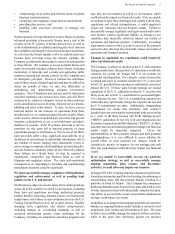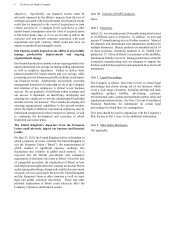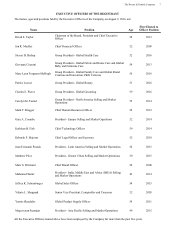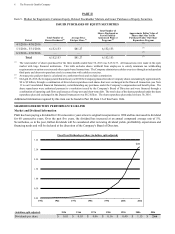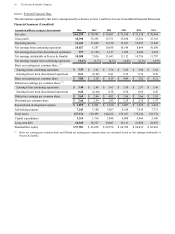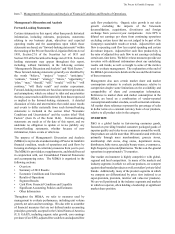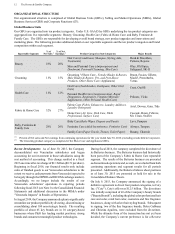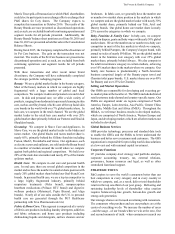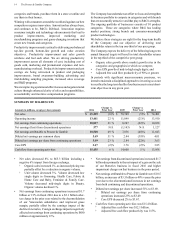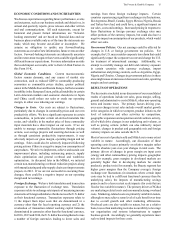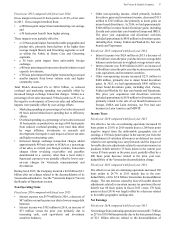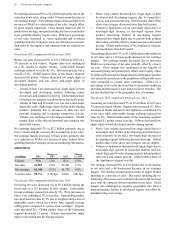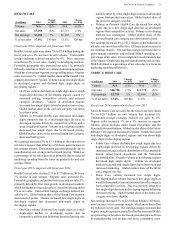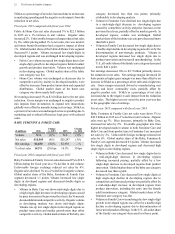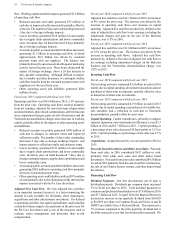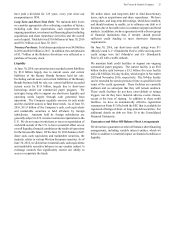Proctor and Gamble 2016 Annual Report Download - page 29
Download and view the complete annual report
Please find page 29 of the 2016 Proctor and Gamble annual report below. You can navigate through the pages in the report by either clicking on the pages listed below, or by using the keyword search tool below to find specific information within the annual report.The Procter & Gamble Company 15
ECONOMIC CONDITIONS AND UNCERTAINTIES
We discuss expectations regarding future performance, events
and outcomes, such as our business outlook and objectives, in
annual and quarterly reports, press releases and other written
and oral communications. All such statements, except for
historical and present factual information, are "forward-
looking statements" and are based on financial data and our
business plans available only as of the time the statements are
made, which may become out-of-date or incomplete. We
assume no obligation to update any forward-looking
statements as a result of new information, future events or other
factors. Forward-looking statements are inherently uncertain
and investors must recognize that events could be significantly
different from our expectations. For more information on risks
that could impact our results, refer to Item 1A Risk Factors in
this Form 10-K.
Global Economic Conditions. Current macroeconomic
factors remain dynamic, and any causes of market size
contraction, such as reduced GDP in commodity-producing
economies as commodity prices decline, greater political
unrest in the Middle East and Eastern Europe, further economic
instability in the European Union, political instability in certain
Latin American markets and economic slowdowns in Japan
and China, could reduce our sales or erode our operating
margin, in either case reducing our earnings.
Changes in Costs. Our costs are subject to fluctuations,
particularly due to changes in commodity prices and our own
productivity efforts. We have significant exposures to certain
commodities, in particular certain oil-derived materials like
resins, and volatility in the market price of these commodity
input materials has a direct impact on our costs. If we are
unable to manage commodity fluctuations through pricing
actions, cost savings projects and sourcing decisions as well
as through consistent productivity improvements, it may
adversely impact our gross margin, operating margin and net
earnings. Sales could also be adversely impacted following
pricing actions if there is a negative impact on consumption of
our products. We strive to implement, achieve and sustain cost
improvement plans, including outsourcing projects, supply
chain optimization and general overhead and workforce
optimization. As discussed later in the MD&A, we initiated
certain non-manufacturing overhead reduction projects along
with manufacturing and other supply chain cost improvements
projects in 2012. If we are not successful in executing these
changes, there could be a negative impact on our operating
margin and net earnings.
Foreign Exchange. We have both translation and transaction
exposure to the fluctuation of exchange rates. Translation
exposures relate to exchange rate impacts of measuring income
statements of foreign subsidiaries that do not use the U.S. dollar
as their functional currency. Transaction exposures relate to
1) the impact from input costs that are denominated in a
currency other than the local reporting currency and 2) the
revaluation of transaction-related working capital balances
denominated in currencies other than the functional currency.
In 2016, 2015 and 2014, the U.S. dollar has strengthened versus
a number of foreign currencies leading to lower sales and
earnings from these foreign exchange impacts. Certain
countries experiencing significant exchange rate fluctuations,
likeArgentina, Brazil, Canada, Egypt, Mexico, Nigeria, Russia
and Turkey have had, and could have, a significant impact on
our sales, costs and earnings. Increased pricing in response to
these fluctuations in foreign currency exchange rates may
offset portions of the currency impacts, but could also have a
negative impact on consumption of our products, which would
affect our sales.
Government Policies. Our net earnings could be affected by
changes in U.S. or foreign government tax policies. For
example, the U.S. may consider corporate tax reform that could
significantly impact the corporate tax rate and change the U.S.
tax treatment of international earnings. Additionally, we
attempt to carefully manage our debt and currency exposure
in certain countries with currency exchange, import
authorization and pricing controls, such as Argentina, Egypt,
Nigeria and Ukraine. Changes in government policies in these
areas might cause an increase or decrease in our sales, operating
margin and net earnings.
RESULTS OF OPERATIONS
The key metrics included in our discussion of our consolidated
results of operations include net sales, gross margin, selling,
general and administrative costs (SG&A), other non-operating
items and income taxes. The primary factors driving year-
over-year changes in net sales include overall market growth
in the categories in which we compete, product initiatives, the
level of initiatives and other activities by competitors,
geographic expansion and acquisition and divestiture activity,
all of which drive changes in our underlying unit volume, as
well as pricing actions (which can also indirectly impact
volume), changes in product and geographic mix and foreign
currency impacts on sales outside the U.S.
Most of our cost of products sold and SG&A are to some extent
variable in nature. Accordingly, our discussion of these
operating costs focuses primarily on relative margins rather
than the absolute year-over-year changes in total costs. The
primary drivers of changes in gross margin are input costs
(energy and other commodities), pricing impacts, geographic
mix (for example, gross margins in developed markets are
generally higher than in developing markets for similar
products), product mix (for example, the Beauty segment has
higher gross margins than the Company average), foreign
exchange rate fluctuations (in situations where certain input
costs may be tied to a different functional currency than the
underlying sales), the impacts of manufacturing savings
projects and to a lesser extent scale impacts (for costs that are
fixed or less variable in nature). The primary drivers of SG&A
are marketing-related costs and non-manufacturing overhead
costs. Marketing-related costs are primarily variable in nature,
although we may achieve some level of scale benefit over time
due to overall growth and other marketing efficiencies.
Overhead costs are also variable in nature, but on a relative
basis, less so than marketing costs due to our ability to leverage
our organization and systems infrastructures to support
business growth. Accordingly, we generally experience more
scale-related impacts for these costs.


